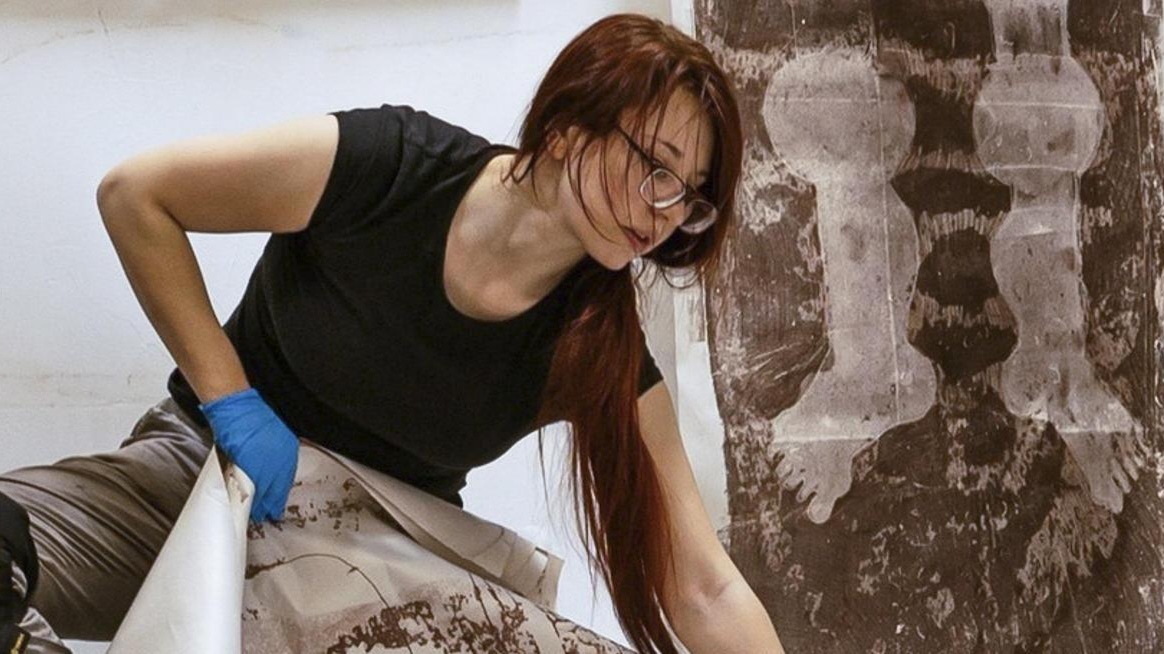Some artists have found it extremely difficult to continue working.
The ongoing Russian invasion has not silenced young Ukrainian artists, who channel their feelings and experience of war into art, while Lviv’s cultural life remains vibrant through thick and thin.
Far from the front lines, the city has been home to many displaced Ukrainians, including professional artists. The city’s many galleries have tried to support them after the war changed their lives.
“Anxiety never goes away,” 28-year-old Marharyta Zhurunova, from Vinnytsia, told EFE at the “Jam Factory” art center, where she and other artists presented the works they created during the “Navigation” program, with the objective of helping them to integrate in Lviv.
Several dozen giant wild rose thorns protrude from two adjacent walls, in an adaptation of Zhurunova’s land art, and represent the anxiety felt by the artist and her co-author, Bohdan Lokatyr.
“Even when I’m abroad, when I’m asked to create something that’s not related to war, I just can’t. Because all my thoughts revolve around that,” says Zhurunova, whose 56-year-old father is fighting in the ranks of the Ukrainian army.
Artist at the “Jam Factory” art center.
Artist at the art center «Jam Factory».
EFE
Some artists have found it extremely difficult to keep working, she says. However, for Zhurunova and many others, art has become a lifeline.
«Perhaps, in our case, art is born from impotence. You feel powerless but still feel the need to do something,” he explained.
There are other recent works by Zhurunova also exhibited in the «Dzyga» gallery under the title «Save me. Help me. Protect me.”
Kostiantyn Zorkin, the curator of the exhibition, believes that while it might seem that there is no place for art in the midst of war, with its “crippling horror, hatred and pain”, right now “art is returning to its mythological power and magical abilities.
“The artist, like millions of Ukrainian women and men, seeks inner support, needs protection, and turns to powerful ancient forces for help,” explains Zorkin.
Variations of a single image, “a warrior, an eternal protector,” cropped up again and again as Zhurunova painted.
Other works by young artists in the “Jam Factory” (a former jam factory turned gallery) revolve around the loss they experienced. Some had to leave all their works behind as they rushed to flee the Russian bombardment. Some lost loved ones.
Illia Todurkin, 22, from Mariupol, collected dirt from around Lviv to recreate the silhouettes of various bodies, to commemorate her friends who were killed during the Russian siege of their hometown.
“Jam Factory” art center.
«Jam Factory» art centre.
EFE
«I cannot go to their graves, I do not know if they are buried or where. But this long and monumental action prompted me to think about them. It is as if here he recreates their bodies from the land that they also touch in Mariupol and creates a temporary monument for them,” the artist explained to gallery visitors.
Her friend, 23-year-old Daria Chechushkova, says she has found protection in Lviv, where life is much more normal than in Odessa, her seaside hometown.
However, it took a while for her to begin to “communicate” with the “stone fortress” of Lviv for the artist who sees interaction with her surroundings as key to her art.
«I grew up in Odessa and I knew very well why I did what I did there. I lacked this in Lviv at the beginning because I did not have a common history with this city,” he explained to EFE.
The artist invited the audience to trace a displaced person’s search for a home by walking along the contours of a seashell that she drew on the city map by placing mosaics at various locations in Lviv.
“When you don’t have a home, you close in on yourself and hide like a shell. But you long for a home and little by little you discover places, people or activities that can make you happy,” Chechushkova explained.
EFE
